Click the names below to read individual abstracts 

Elise Adamson, Chemical, Biochemical and Environmental Engineering
Optimization of Biomaterial Microenvironment for Motor Neuron Tissue Engineering
Faculty Mentor: Jennie Leach
Expected Graduation Date: Spring 2017
Injury and disease in the nervous system result in loss of sensory and motor neurons. Tissue engineering research has great potential to develop more effective therapeutics by combining appropriate biological cues with responsive biomaterial architectures. We have recently shown that more in vivo-like sensory neuron responses are found in three-dimensional culture versus two-dimensional substrates. Unfortunately, primary motor neurons are difficult to isolate and culture compared to sensory neurons. NSC-34 is the major mouse cell line model for motor neurons but is poorly characterized and rarely used in bioengineering. A motor neuron model, such as NSC-34, may advance research in nerve damage therapies. The aim of this work is to systematically characterize NSC-34 cells and optimize culture conditions for tissue engineering applications. To characterize NSC-34 in 3D, I will culture cells in hydrogels composed of various extracellular matrix proteins relevant to motor neuron microenvironment. Preliminary results from 3D gels indicate that both laminin and collagen IV provide environments more favorable for neurite expression than collagen I alone. Ongoing work will focus on characterizing neuronal morphologies and neurite lengths in 3D cultures as well as analyze the impact of growth factors on neurite expression and length.
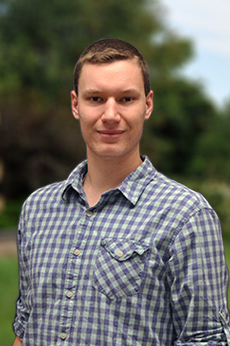
Joshua Amason, Biochemistry and Molecular Biology
Identifying Activating Mutants for sGC Via High Throughput Luciferase Assay
Faculty Mentor: Elsa D. Garcin
Expected Graduation Date: December 2016
The goal of this project is to identify novel activating mutations in the human enzyme soluble guanylate cyclase (sGC). The long-term goal of our lab is to define the molecular mechanism by which sGC is activated by nitric oxide (NO) to produce cyclic guanylate monophosphate (cGMP) from guanylate triphosphate (GTP). cGMP is a crucial messenger in the vascular system, relaxing smooth muscle tissue, making sGC a validated drug target for vascular disorders. However, the mechanism by which NO activates sGC remains unknown. sGC is a heterodimeric enzyme with an active site located in a cleft between the two subunits. We seek to understand how NO influences the orientation of these dimers upon activation. These discoveries will be crucial in understanding the structural transitions and conformations for sGC activation as well as designing small molecules to modulate sGC transitions. In order to accomplish this goal, random mutations in the sGC gene will be generated by error prone polymerase chain reaction (PCR). Next, a screening assay developed by our lab will be utilized to identify sGC mutants with increased catalytic activity. These active mutants are the cornerstone in determining which residues are responsible for increased activity by x-ray crystallography.
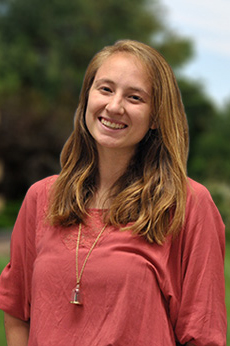
Hannah Aris, Chemical, Biochemical, and Environmental Engineering
Recovery of Nutrients from Chicken Litter to Create a Slow-Release Fertilizer
Faculty Mentor: Lee Blaney
Expected Graduation Date: Spring 2018
Recently enacted statewide environmental regulations have made it increasingly important to recover nutrients, namely nitrogen and phosphorus, from chicken litter in the form of high-value fertilizers. Currently, high levels of nutrients are introduced to the Chesapeake Bay as runoff containing animal manure and fertilizers. These nutrients fuel the growth of algal blooms, which jeopardize water quality and ecological health. The goal of our research is to recover nutrients from chicken litter to decrease the amount of these nutrients in the water. The litter is mixed with water to form a high-solids slurry, whose pH is decreased to approximately 4.3 (our previously-determined pH for optimal phosphorus release from the chicken litter) by bubbling carbon dioxide and dosing hydrochloric acid. After separating the solids, sodium hydroxide is added to the nutrient-rich solution until it reaches pH 8.8- the previously-obtained pH at which struvite (NH4MgPO4·6H2O) precipitation is optimal. Trace amounts of potassium struvite, hydroxyapatite, newberyite, and monetite, are also generated. By implementing the high-phosphorus struvite (recovered from normally polluting chicken litter) as a slow-release fertilizer, excess nutrient levels in watersheds will decrease drastically. Struvite production from animal waste also represents a long-term sustainable phosphorus supply as mining for the resource becomes limited.
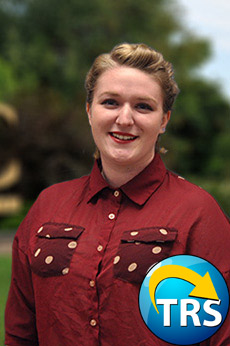
Sarah Riley Auer, Ancient Studies
“Through the Eyes of a Maia”
Faculty Mentor: Molly Jones-Lewis, David Rosenbloom
Expected Graduation Date: Spring 2017
Due to societal taboos involving the female body and childbirth throughout the ancient world, women played a primary role in the treatment of so called “female diseases” and an exclusive role in normal childbirth. Male doctors and healers often employed women as intermediaries in the treatment of female clients, and it is generally recognized that doctors such as Hippocrates and Soranus wrote their authoritative treatises on female diseases based upon information given to them by such intermediaries. My research will study the development of female liaisons into full-fledged and acknowledged medical professionals in Imperial Rome. By analyzing documentary evidence, primarily funerary inscriptions of female medical practitioners, and accompanying relief sculptures, I will determine the terms in which they were identified as obstetricians, gynecologists, and midwives, rather than interagents between doctors and patients. Although historians have studied inscriptional evidence, the reliefs accompanying the inscriptions, a potentially rich source of information, have received scant treatment. It is essential that we add this dimension to the study of the early female medical professionals in the Roman Empire. This project will tell the story of the women who self-identified as medical professionals by situating these few surviving women within the wider development professional medicine in the West.
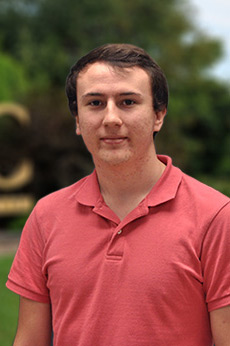
Kyle Belluomo, Physics
Modeling Plasmon Frequencies inside Gold Nanoparticles
Faculty Mentor: Matthew Pelton
Expected Graduation Date: Spring 2017
Plasmons are the collective electron oscillations inside metal nanoparticles; the frequency of these oscillations is highly dependent on the shape and composition of the metal. It has been shown before that you can couple these plasma oscillations to semiconducting nanoparticles (also known as quantum dots) to produce a change in how much light is scattered or absorbed by the plasmonic metal. The goal of this project is calculate the plasmon frequencies inside gold particles and model the scattering and absorption of light incident on a coupled gold particle and quantum dot system. To calculate the plasmon frequencies and model this system, a solid quantitative understanding of the coupled electric and magnetic fields inside the gold particle is necessary. To achieve this, I will use a numerical approach such as the Finite-Difference Time-Domain method. This numerical method calculates the electric and magnetic fields by solving Maxwell’s Equations directly, making it a very intuitive and flexible method for determining the fields of interest. Once we know the fields, we can then relate these fields to the energy flux over the surface of the metal nanoparticle to yield a clear picture of the absorption and scattering due to the metal nanoparticle. A graduate student working in the same lab will attempt to experimentally measure the scattering and absorption of light on the exact system that I am modeling, whereby after we will be able to compare the calculations I performed to the experimental results.
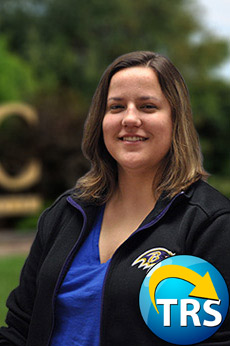
Renee Booker, English
9/11 through the Eyes of the Millennial Generation
Faculty Mentor: Michele Osherow
Expected Graduation Date: Fall 2017
This research will collect various experiences and recollections from people who were children at the time of 9/11 in order to look at how those attacks were a common point of awakening among the members of my generation. The research also plans to look at how the attacks continue to affect those individuals today. Psychologists have studied children’s reactions to this trauma, and there have been a number of both academic and news articles written in relation to this subject. However, the approach and format for this project is unique. I plan to take elements of the recollections collected, as well as my own, and combine them into a nonfiction book. This book would be in the form of a narrative timeline which would combine the factual/technical elements of that day (significant times, events, etc.) with the personal experiences collected. The aim of this book is to appeal to a wide range of ages, from middle school-aged children through the Millennial Generation. An effect of the timeline will emphasize the enormous impact that one single day can have on an entire generation.

Cara Borja, Psychology
The Emergence of Biculturalism in First-generation Latino/a and Hispanic Immigrants
Faculty Mentor: Anne Brodsky
Expected Graduation Date: Spring 2017
Individuals of Hispanic origin constitute the largest minority group in the United States. First-generation immigrants face the challenge of identifying with U.S. American culture while sustaining their cultural roots. The challenge of adopting mainstream culture while maintaining their native values urges first-generation immigrants to adopt biculturalism and create a dual cultural identity. Biculturalism, in this context, is defined as the embodiment of both one’s ethnic culture of origin and one’s culture of residence. Bicultural competence provides the skills needed for the individual to navigate the behaviors and expectations of both cultures. The purpose of this study is to analyze the process of biculturalism and investigate factors that play a role in its emergence in first-generation Latino/a and Hispanic immigrants. This study will also explore the conflict and interconnection between the processes of acculturation and cultural maintenance in bicultural individuals of this population. The analysis is based on 15 semi-structured interviews with first-generation Latino/a and Hispanic immigrants living in the Baltimore/Washington D.C. area. The ultimate goal of the study is to understand how first-generation Latino/a and Hispanic immigrants can successfully cope with the demands of a dual cultural world.
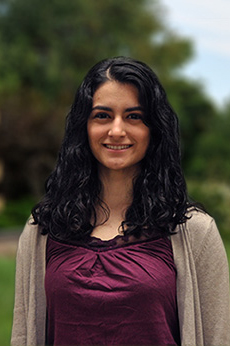
Gabriela Canales, Biological Sciences
Increasing the Frequency of CRISPR Cas9-Associated Homology-Mediated Repair Using Phage Recombination Proteins
Faculty Mentor: Charles Bieberich
Expected Graduation Date: Spring 2017
Ms. Canales’ abstract has been held at the request from her mentor.

Kristofer Castro, Psychology
Social Standing as a Moderator of Perceptions of Racial Discrimination and Well-Being in Asian Immigrant Mothers
Faculty Mentor: Charissa Cheah
Expected Graduation Date: Spring 2017
Asian immigrants are the fastest-growing racial group in the United States. Still, Asian immigrants experience a large amount of racial discrimination. This discrimination includes the behavioral practices or social structures used to denigrate individuals of a group based on ethnic identity or skin color. Racial discrimination in Asian Americans has been shown to decrease the psychological well-being of those that perceive it. However, the role of perceived social standing and economic opportunity as a moderator in that negative relation has not been shown. The research to date has shown the role SES plays as a buffer in other ethnic groups in the U.S. along with other such moderators (e.g. social support and acculturation). This research aims to examine: (1) the association between first-generation Asian immigrant mothers’ perceptions of racial discrimination they experience in the U.S. and their psychological well-being, and (2) the moderating role of maternal perceptions of economic opportunity and social standing in the U.S. in the association between maternal perceptions of racial discrimination and maternal psychological well-being.
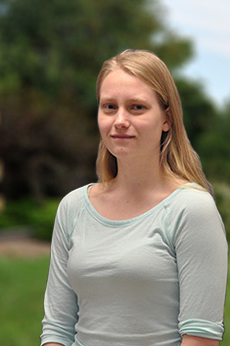
Jennifer Christhilf, Geography and Environmental Systems
Andros Island Vegetation Types: Habitat Usage Patterns of the Bahama Oriole
Faculty Mentors: Kevin Omland and Matthew Fagan
Expected Graduation Date: Spring 2018
New World Orioles have evolved into over thirty different species throughout many different environments in the New World. An isolated species, the Bahama Oriole, used to be found on two islands in the Bahamas, Andros and Abacao, until it went extinct on Abacao in the 1990s. The Bahama Oriole is a critically endangered species, with the latest population survey in 2009 estimating their population to be between 190 and 240 individuals. Understanding the Oriole’s habitat types and their availability through classification is a key aspect of estimating the population size and determining breeding areas, which better prepares researchers and conservationists to protect this species. This project will create a habitat classification strategy for Bahama Oriole key habitats on North Andros Island, Bahamas using satellite imagery and determine the accuracy of various classification techniques through field verification. I will classify different vegetation/forest habitats, compare different automated programs for defining habitat boundary lines, ground verify classifications, evaluate accuracies of different classification strategies, and determine the oriole’s habitat needs. The final classification map will be used for conservation of the Bahama Oriole and other endangered species on Andros Island.
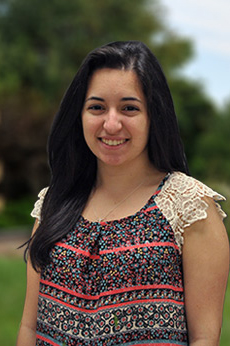
Ann Cirincione, Bioinformatics
Identification of Molecular Properties to Cluster Genetic Markers of Cardiovascular Disease
Faculty Mentor: Maricel Kann
Expected Graduation Date: Spring 2018
Cardiovascular disease (CVD) is the leading cause of death worldwide in both men and women. It is especially prevalent in the United States, where it is responsible for one out of every four deaths. Genetic markers linked to susceptibility to CVD have been identified, however a large number are still unknown. We have mapped 15% of disease variants from the Human Gene Mutation Database (HGMD), 62% from the Clinical Variance database (ClinVar), and 28% from the Universal Protein Resource (UniProt) to the Online Mendelian Inheritance in Man (OMIM), which has direct links to the Human Phenotype Ontology (HPO). From these variants, we will extract the subset linked to CVD, as well as increase coverage of variants mapped to OMIM. We aim to use machine learning techniques and algorithms to cluster new genetic variants to molecular properties of known CVD markers in order to better diagnose and treat individual patients. For this purpose we have compiled a list of molecular properties including protein domain interactions, common gene ontologies, and metabolic pathways. In the future, these methods will be used to match individual genome data to corresponding CVD clusters, developing new diagnostic tools to personalize and optimize diagnosis of CVD.
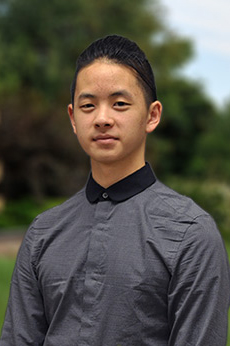
Stephen Dan, Dance
East vs. West: Closing the Gap between Dance Styles
Faculty Mentor: Doug Hamby
Expected Graduation Date: Spring 2017
I plan on researching the footwork, musicality, and training techniques, as well as the emotional, professional, and creative approaches to making choreography in the L.A. area. Dance is very diverse, and there are significant differences in technique, style, and skill between East coast and West coast hip-hop. Currently, the hip-hop community views the west coast as superior, or higher caliber, but I want to change that. In order to do so, I plan on booking one-on-one sessions at the Building Block Dance Studio, in California, run by Keone and Mariel Madrid. These two are some of the most well known choreographers in my style of hip-hop, and they have won many dance competitions in the Los Angeles area with their company Cookies. I plan using my research to create a dance for the Fall Dance Showcase and URCAD to display the different techniques I have acquired. I am also a choreographer for the hip-hop team on campus, Major Definition, and can disseminate what I have learned in a more in depth process. This would not only improve us as a team, but because we are a competition team, we will push the standard of dance in our area, and decreasing the disparity in skill between the East and West coasts.
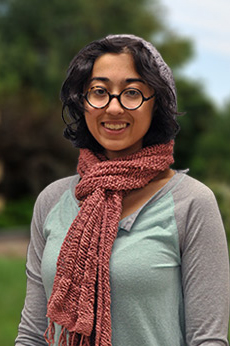
Natalie DeNigris, Physics
Searching for X-Ray Variability in Resolved Jets from Black Holes
Faculty Mentor: Eileen Meyer
Expected Graduation Date: Spring 2017
Nearly all large galaxies host a super-massive black hole (SMBH) at their centers, on the scale of one million to one billion solar masses. These black holes can collect gas and dust, forming an ‘accretion disk’, which can become so luminous that it outshines the host galaxy. In some cases, accreting black holes also produce bipolar jets of fully-ionized plasma moving near the speed of light. The origin of these jets is not fully understood; however, they are large enough (hundreds of thousands of light-years) to be resolved by high-resolution telescopes such as the Hubble Space Telescope (optical wavelengths) and the Chandra Space Telescope (x-ray wavelengths). The jets also produce synchrotron (ST) radiation, which can be observed in the radio through optical bands; still, the nature of x-ray emission from the jets is a long-standing mystery. The purpose of this project is to examine variability in the x-ray emission of jets using Chandra’s open-source archive of X-ray imaging data. We will test variability by measuring the flux in jet knots over multiple observations for the same source. Any variability observed would conclusively rule out one of the two competing models for the X-ray emission, namely, the inverse-Compton (IC) model. On the other hand, if we detect significant variability, the ST radiation model would be preferred. Ultimately, resolving the mystery of the X-ray emission in extragalactic jets is an important step in understanding how black holes influence their surrounding environments.

Nimasha Fernando, Biological Sciences and Interdisciplinary Studies: Intercultural Health
Draws and Dilemmas of Traditional Healing Remedies Utilized by Members of Baltimore’s Latin American Immigrant Community
Faculty Mentor: Bambi Chapin
Expected Graduation Date: Spring 2017
In recent years, the immigrant population of Baltimore City has greatly increased, with foreign-born residents comprising 7.8% of the city’s population. Immigrants, especially those with limited English language proficiency and minimal financial resources, are more likely to employ alternative health methods in an effort to self-medicate instead of seeking biomedical care. Individuals should be permitted to use their own cultural practices for healing if they are not dangerous, but biomedical testing is necessary to investigate the safety of such practices while imperative social scientific analysis can help determine whether the population is being deprived of resources, such as biomedical health care, and thereby turning to potentially less effective, more hazardous methods of healing. My research aims to investigate natural and traditional remedies used by Latin American immigrants in Baltimore, where 43.1% of the city’s foreign born population is Latin American. To accomplish my research aims, I will employ an anthropological ethnographic approach integrated with public health to conduct semi-structured, in-depth interviews with Latin American immigrant focal subjects from the Baltimore area. I will next code the interviews to identify response patterns and individual variations regarding frequency of traditional remedy use, motivation and preference for use of such remedies in comparison to allopathic medical care, and communication with biomedical focused health care providers regarding use of alternative healing methods. This focused research will provide findings regarding immigrants’ health care experiences, and provide information for health care decisions in diverse cultural environments.
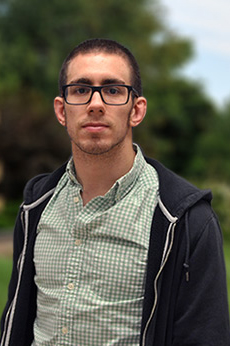
Marshal Golden, History
Respectable Violence: Boxing Regulation and Victorian Moral Reform
Faculty Mentor: Daniel Ritschel
Expected Graduation Date: Fall 2016
Moral reform in 19th century Britain largely came about due to widespread industrialization, urbanization, and the rise of the Victorian middle class. These developments produced not only economic stratification, but also profound cultural divisions. As working class leisure became visible to the “respectable” middle classes in London and other urban centers, observers became appalled at the violence, sexuality, and depravity that characterized the pastimes of common laborers. Prostitution, gambling, drinking, street entertainment, and “blood sports” like cock-fighting and bull-baiting all became targets of “moral reform”. Bare-knuckle boxing came under particular scrutiny by Victorian moral reformers. For its working class audience, backstreet boxing offered a display of strength, resilience, and manliness. Its bourgeois critics, by contrast, were as critical of the bloodthirst “rabble” that attended these events as of the members of the aristocratic elite who frequently joined the audience, bet on the outcome of bouts, and even sponsored elite fighters. Moral reformers came to see boxing as little short of violent street-fighting. While many studies of the legality of the boxing have been conducted, few accounts are given of the working class narrative. This study will focus on how the working class fighters and boxing fans interacted with the law under both the Broughton Rules, and the Marquis of Queensbury rules. Analysis of this class conflict will shed light on the early regulation of the modern sport of boxing. The regulation and commercial exploitation of violence says much about the nature of Victorian society and culture.
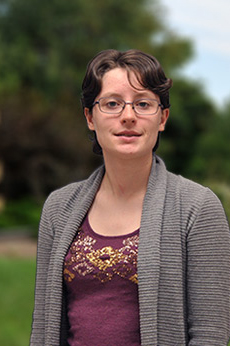
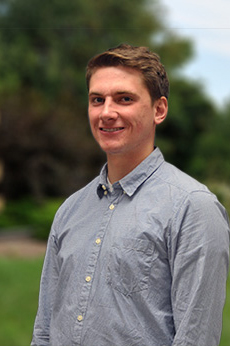
Amelia Hallworth, Biological Sciences
Benjamin Sparklin, Biochemistry and Molecular Biology
Investigating Circadian Control within the TGA3 Promoter
Faculty Mentor: Hua Lu
Expected Graduation Date: Spring 2017 and Spring 2018
Successful defense against pathogens is critical for the survival of plants. Previous work from many research groups, including our group, has shown that the circadian clock plays a role in regulating the immune system, particularly the branch controlled by salicylic acid (SA). However, the regulatory mechanisms for such a control are mostly unknown. TGA3 is a transcription factor that promotes the expression of defense related genes when activated by SA. It also exhibits daily oscillations, suggesting circadian control of the gene. However, it is currently unknown how the circadian expression of TGA3 is regulated. We will clone various lengths of the TGA3 promoter into a vector that fuses the promoter fragments with the luciferase reporter gene. We will use Agrobacterium tumefaciens to transform Arabidopsis thaliana with the promoter-luciferase constructs and screen for transformed individuals. We can measure luminescence as a marker for promoter activity to determine which promoter fragments, when lost, lead to changes in the circadian pattern.

Maniraj Jeyaraju, Interdisciplinary Studies
Ethnographic Study of Cardiovascular Disease Attitudes among Adolescents in India
Faculty Mentor: Sarah Chard
Expected Graduation Date: Spring 2017
Established as the leading cause of death worldwide, cardiovascular disease is a complex, multi-causal issue. Understanding the sociocultural construction of this non-communicable disease would advance our knowledge of how to improve care to vulnerable populations. Focused on a specific district in India, the purpose this study is to identify cultural beliefs and attitudes towards cardiovascular health among middle school students. A culturally sensitive and specific board game will be engineered to facilitate a conversation among the adolescents; this interaction will be primarily documented through ethnographic methods and surveys. This project is testing a methodological innovation, the board game, which may contribute to tools utilized to gather ethnographic data. Furthermore, understanding cultural beliefs and practices will allow healthcare professionals to advance through checks and balances when making sense of cardiovascular disease morbidity.
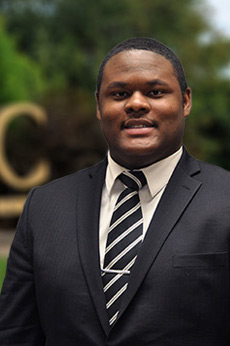
Da’Kuawn Johnson, Biochemistry and Molecular Biology
Functional Characterization of Glycoside Hydrolase Family 43 in Plant Cell-Wall-Degrading Bacteria
Faculty Mentor: Jeffrey G. Gardner
Expected Graduation Date: Spring 2017
The polysaccharides that comprise the plant cell wall are the most abundant sources of fixed carbon on the planet. These polymers are efficiently recycled by bacterial degradative activities with a sophisticated suite of enzymes (glycoside hydrolases, GH) capable of converting the insoluble polysaccharides to soluble simple sugars. In Cellvibrio japonicus, there are over 200 GHs that allows for complete degradation of the plant cell wall. A major goal of our research group is to understand, why C. japonicus has so many GH enzymes, what specific substrates they are active on, and which are essential or accessory for plant cell wall degradation. One such class of GH currently being examined by our group is the glycoside hydrolase family 43 (GH43), which have been predicted to have activity on hemicellulose and pectin, two major polysaccharides that compose the plant cell wall. In C. japonicus, there are fourteen genes predicted to belong to the GH43 family, and to initially characterize these genes we have created in-frame deletions of each of the GH43 genes and tested for growth defects on hemicellulose and pectin substrates. Three of the single deletion mutants, CjΔgly43F, CjΔgly43C, and CjΔgly43E, have shown reproducible growth rate defects on the polysaccharides xylan or arabinan. Guided by phylogenetic analysis, we are currently creating C. japonicus strains that have multiple GH43 genes deleted, allowing us to address the issues of enzyme synergy or functional redundancy. Once we have identified the cognate substrates for the GH43 enzymes via mutational analysis, we will further characterize the GH43 enzymes via protein purification and kinetic analysis. From these data, we will refine our model of hemicellulose and pectin degradation in C. japonicus.
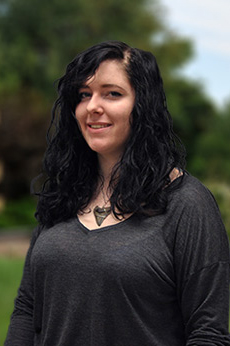
Flora Kirk, Ancient Studies
Roman Coins in the Second and Third Century AD and their Role in Immortalizing Emperors
Faculty Mentor: Melissa Bailey
Expected Graduation Date: Spring 2018
This research studies Roman coins from the second and third centuries CE and their use as a means of communication for Rome’s emperors. In a time where the spread of literature was limited and the empire vast, coinage was the only medium that reached everyone under Rome’s influence. How did the coins’ imagery change as the 3rd century brought shorter reigns and restricted resources? What messages were the emperors attempting to convey to the people throughout this turbulent century? This study explores the currency’s changing strategies of communication from the second to the third century. Along with transforming imagery, this study will investigate how the physical characteristics of the coins – the amount of silver, the weight, the level of wear and use – all contribute to the emperors’ strategies of communication throughout the period. By examining the imagery of coins based on category (tradition, military problems, dynastic emphasis, personal preferences, disasters, and civic prosperity), one can begin to identify trends and their correspondence to contemporary events. This research will explore how as their propaganda evolved, so did the physical aspects, affecting the public reception of the coins.
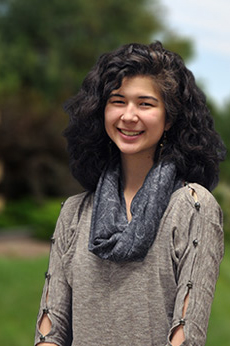
Justine Lottermoser, Biochemistry and Molecular Biology
The First Electrochemical, Aptamer-Based Sensor on a Carbon Surface
Faculty Mentor: Ryan J. White
Expected Graduation Date: Spring 2017
The most common hereditary mental developmental disorder, Fragile X Syndrome (FXS), is one of the few known genetic causes of autism. A recent study suggests FXS neurons can be rescued by interactions with healthy astrocytes, integral cells in the central nervous system, thus opening a potential new therapeutic strategy. Unfortunately, little is known about astrocyte-neuron interactions as there are no proper tools available to gain further insight. Adenosine triphosphate (ATP) is a molecular messenger utilized by astrocytes and is thus presumably an integral component in astrocyte-neuron interactions. Consequently, gaining information about the mechanism and spatial location of ATP release will advance our understanding of the role of astrocytes in FXS and autism. Our project is aimed at developing a tool capable of single-cell monitoring by fabricating an electrochemical, aptamer-based biosensor on carbon fibers. Aptamers are short DNA or RNA sequences selective for target analytes and translate binding into an electric signal. Carbon fiber represents a material suitable for single cell and in vivo analyses. Additionally, it has favorable electrochemical characteristics enabling high signal-to-noise measurements not achievable with current sensors. As such, we are developing a strategy for covalently linking aptamers to carbon electrode surfaces.
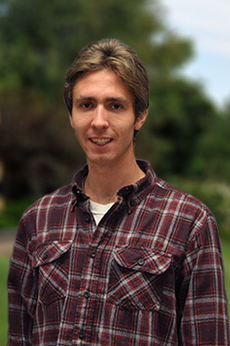
Jonathan Luckin, Physics and Mathematics
Understanding the Mysterious Energy Content of the Lobes of Radio Galaxies through Numerical Simulations
Faculty Mentor: Markos Georganopoulos
Expected Graduation Date: Spring 2017
The energy content of the radio lobes of powerful radio galaxies is an important unknown in the study of the effects of the radio lobes on galaxy and galaxy cluster evolution. Astronomers usually assume that the magnetic field and relativistic electrons in the lobes are in energy equipartition, a reasonable assumption because that configuration is most economical and minimizes energy in the radio lobe for a given level of observed radio emission. After developing analytical and numerical tools to evaluate if the magnetic fields and electrons in the lobe are in equipartition, we will derive the intrinsic lobe power distribution from a range of equipartition profiles using the third Cambridge radio catalogue. We will then produce synthetic samples of radio lobes for different equipartition profiles from the derived intrinsic lobe power distribution. We will censor these samples for the radio catalogue sensitivity limit and evaluate the equipartition factor distribution as a function of the observed volume.

Navaal Mahdi, Media and Communication Studies
An Ethnographic Review of the Impact of the One Direction Fandom
Faculty Mentors: Bryce Peake and Donald Snyder
Expected Graduation Date: Spring 2017
Social Media has provided fans with a platform for communicating their fandom to the world. While fandom has traditionally been argued as passive (and at times obsessive) consumption, fans are active in the promotion of their passions. This multimedia ethnography explores the increased power of fans within the realm of popular music marketing through the lens of One Direction, a popular English/Irish boy band formed in 2010. The research examines the role of social media in facilitating fan interaction, connecting with band, and communicating the importance and value of popular music to a global audience.
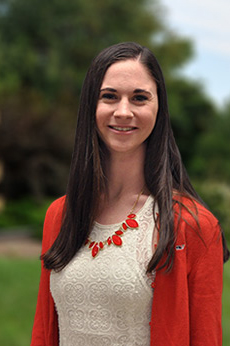
Megan Mellon, Dance and Biology
DANCE: Dance Anatomy and New Choreographic Elements
Faculty Mentor: Doug Hamby
Expected Graduation Date: Spring 2017
The arts and sciences are often seen as two distinct disciplines, and I am propelled to bring awareness to the underlying connection between the two. In dance, the human body is the artist’s tool with which to create. This research seeks to study how the anatomical structure and physiological processes of the body support dance movement. Muscular composition, joint capability, and osteological symmetry and asymmetry will be analyzed. I will be studying at Bates Pre-Professional Summer Dance Intensive, immersing myself in an academic dance environment for several weeks, where I will learn a variety of dance styles and movements, and discuss with instructors how the physicality of the body supports their movement style. With this knowledge, I will be presenting my findings at the Senior Dance Concert for my senior capstone project, in which I will choreograph a ten-minute dance elaborating of the abilities of dance movement in the human body explained by anatomical structure.

Sarah Miller, Interdisciplinary Studies: Global Perspectives in Documentary Photography
Photographic Documentation to Augment Anthropological and Environmental Research on Rio Doce Mining Disaster
Faculty Mentor: Lee Boot
Expected Graduation Date: Spring 2017
On November 5, 2015, in Mariana, Brazil, a dam at a mine burst, leaking 50 million cubic meters of toxic mineral waste into the Rio Doce (Sweet River). Brazil’s interior minister calls the spill the worst environmental disaster Brazil has ever seen and many predict it will take decades for the area to come close to recuperating. I will be photographically documenting the effects on the communities of the Rio Doce Valley when I travel to the Brazilian state of Minas Gerais this summer. I will meet up with Andrés Camacho, a recent UMBC graduate, who is currently biking the length of the Rio Doce and interviewing the people who live there in order to gauge residents’ reactions and tell their stories. Together we will produce a photographic essay on the current state of the area complete with first-hand interviews of those affected in hope of creating awareness of the Rio Doce Valley disaster and its aftermath. Additionally, I am collaborating with a Georgetown professor who is gathering an international group of scholars to study the historical background of the area and the disaster’s current environmental and social repercussions on the Rio Doce valley. I will be contributing to his project by providing photographs to be used in his upcoming website and Andrés will be providing interviews and written accounts for the site as well. As I have been studying in Brazil for the past seven months, I am excited to put my knowledge of the culture and language to work on this project and am interested in hearing about this disaster from those most directly affected. Furthermore, as a photographer, I am eager to participate in a collaboration of this nature to grasp the feasibility of similar collaborations in the future.
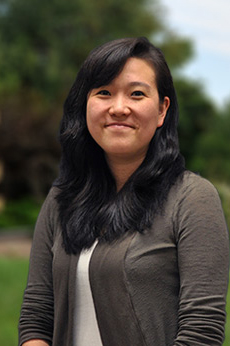
Sylvia Min, Biological Sciences
Understanding the Role of the Novel Histone Methyltransferase Set5 in Chromatin Assembly
Faculty Mentor: Erin Green
Expected Graduation Date: Spring 2017
Chromatin is the packaging of histones and DNA in the nuclei of all eukaryotic cells and my primary research project focuses on understanding the biological function of an enzyme that modifies chromatin. This type of chromatin modification is known to be important for the ability of cells to regulate their gene expression and respond to environmental stresses. In particular, I am studying the enzyme Set5, using the model system budding yeast, and investigating links between Set5 and the process by which DNA and histones are packaged together. I have two specific aims with my research: (1) perform a biochemical characterization of interacting partners for the chromatin-modifying enzyme Set5 and (2) undertake a genetic and molecular investigation of the role of Set5 in chromatin assembly. The completion of these two aims will uncover more about how Set5 works at the molecular level, what other proteins it interacts with, and its potential role in chromatin assembly.
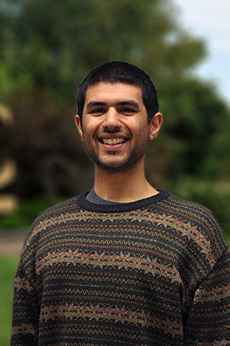
Sean Najmi, Chemical, Biochemical, and Environmental Engineering
Immobilization of the Glutamine Binding Protein (QBP) onto the Surface of Transparent Microbeads for use in a Biosensor
Faculty Mentor: Leah Tolosa
Expected Graduation Date: Spring 2017
There are over 29 million people in the United States who are diagnosed with diabetes, of which most have type 2 diabetes. Because glutamine concentration circulating through the blood is reduced significantly in patients with type 2 diabetes compared to healthy ones, there needs to be a way to determine the glutamine levels that are present in blood circulation. The goal of this study is to immobilize the glutamine binding protein (QBP) onto the surface of different types of transparent beads for use in a biosensor. The QBP was grown from Escherichia coli and then labeled with the fluorophore acridine. After it was labeled, the QBP ran through a DEAE column where the protein was purified and excess dye was removed. It was then measured in an assay to determine its response to different concentrations of glutamine. The QBP was then immobilized onto the surface of Ni-NTA beads and gellan beads.


Nhu Nguyen and Kathleen Pagarigan, Chemistry and Biochemistry
Optimization of Alkyl Radical Synthesis via Photo-induced Decarboxylation
Faculty Mentor: Lisa Kelly
Expected Graduation Date: Spring 2017
Alkyl radicals have significant applications in photo-labeling, synthetic organic chemistry and radical-initiated polymerization. However, the traditional method of synthesizing radicals from an organic halide with azobisisobutyronitrile (AIBN) is hindered by the toxicity of halogens and the elimination of the nonspecific metal byproduct. Previous work from our lab has suggested a mechanism generating alkyl radicals intermediates via photo-induced electron transfer (PET) decarboxylation from naphthalene diimide (NDI) carboxylic acid derivatives. The radical intermediate was evident by the formation of an adduct with the trapping agent, bovine serum albumin. This research seeks to optimize the green, halogen-free mechanism of synthesizing alkyl radicals by varying the carbon spacers on the NDI derivative and alternating trapping agents. Using high performance liquid chromatography to characterize the efficiency of the adduct formation, we can suggest the optimal NDI derivative structure. Furthermore, if the interaction between the trapping agent and NDI derivative is productive, the resulting adduct will absorb UV light stronger over a longer range of wavelengths than those of known photoreactive groups – effectively making it more specific and efficient for photolabeling.
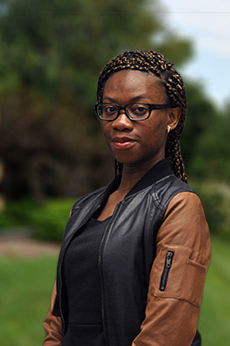
Vanessa Nwaiwu, Biological Sciences
Developing Highly Parallel and Flexible Nano-Reaction Chambers
Faculty Mentor: Minjoung Kyoung
Expected Graduation Date: Spring 2017
The goal of my project is to develop a nano-scale vesicle reaction chamber that would allow for the studying of transient weak protein-protein interactions. This nano-reaction chamber would be created from multiple fusion rounds between lipid vesicles encapsulating proteins at the single molecule level to investigate weak protein-protein interactions. The first round of fusion would occur between two oppositely charged vesicles due to charge-charge interactions and subsequently, the contents of both vesicles would mix with each other. The next fusion round would be made possible by SNARE proteins fusion machinery which are incorporated into the vesicles. A system capable of multiple rounds of controlled fusion would allow for sequential addition of multiple components to the reaction chamber under observation. My specific aims are: (1) create nano-vesicles with charged lipids and test the fusion efficiency (2) optimize the charge strength on the lipid surface to maximize the fusion efficiency (3) create nano-vesicles with SNARE proteins and test the fusion efficiency (4) optimize the SNARE proteins to lipid ratio on vesicles to maximize the fusion efficiency. The proposed project would develop a novel reaction chamber system that would completely transform the study of weak protein-protein interaction at the single molecular level. Designing vesicle pairs that fuse, mixing content stored inside may allow for controlled small volume mixing experiments. The information obtained from this project can help us better understand myriad biological processes and pathways composed of weak protein-protein interactions that have not been properly investigated due to technical difficulties.
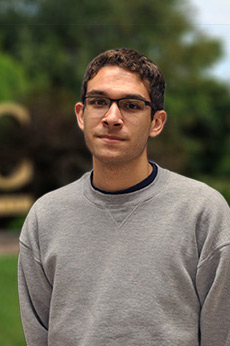
Daniel Ocasio, Chemical, Biochemical, and Environmental Engineering
Photokinetic Determination of Environmentally Relevant Pharmaceuticals for UV-Based Applications in Treatment Facilities
Faculty Mentor: Lee Blaney
Expected Graduation Date: Spring 2017
Pharmaceuticals and personal care products (PPCPs) have been known contaminants of municipal water and wastewater systems in the United States since the 1960s. Drinking water and wastewater treatment plants are often equipped with UV treatment systems that are capable of transforming PPCPs into benign products. However, no regulations are in place to monitor the fate of antibiotics. The purpose of this study was to determine how antibiotic photodegradation kinetics affect the composition of products from UV-induced degradation. Three classes of compounds (i.e. fluoroquinolones, tetracyclines, and sulfonamides) were hypothesized to yield transformation byproducts as a result of UV exposure. Due to the wide variability in water quality, the relationship between pH and kinetic parameters was studied. Samples were prepared at eight different pH values in the range 2-12 for each compound and irradiated in a photoreactor at the germicidal UV-C range, 253.7 nm. We determined the fluence-based rate constant, quantum yield, molar absorptivity, and transformation products for three antibiotics from each class. The results indicate a clear dependence on pH for all kinetics and formation of antimicrobially-active transformation products during UV treatment.
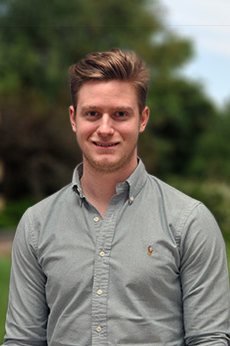
Brian O’Connor, Chemistry
Structure-Activity Relationship of the Sugar Moieties in Flex 4-Methoxy Guanosine
Faculty Mentor: Katherine Seley-Radtke
Expected Graduation Date: Spring 2017
Middle East Respiratory Syndrome (MERS) and Severe Acute Respiratory Syndrome (SARS) are emerging human coronaviruses (CoVs) with no FDA approved vaccines or treatments. The current mortality rate for those who have contracted MERS is approximately 36%. Recently, flexible nucleoside-based antiviral compounds (fleximers) have shown marked potential combating MERS – the first time that nucleoside-based compounds have ever shown activity against a CoV. A fleximer is a purine nucleoside that has had the imidazole and pyrimidine rings separated by a single carbon-carbon bond. This separation allows the fleximer to undergo conformational changes that would otherwise be impossible, increasing its bonding affinity, whilst not interfering with the hydrogen bonding moieties. The lead compound for this project is a fleximer version of Acyclovir, a broad-spectrum antiviral medication. While the lead compound has shown activity against MERS, it does not show activity against SARS. I will complete a structure-activity relationship study where I will make four distinct compounds; two will have a 5 ′ hydroxyl group, and the other two will have a 5 ′ acetyl group. Both the hydroxyl and acetyl versions will contain the cyclic sugar moiety, and the imidazole-pyrimidine carbon-carbon bond will be made in both a proximal and distal form. The aim of the project is to elucidate the mechanism by which our lead compound disrupts viral replication and further reveal the relationship between the flex-base moiety of guanosine, the sugar moiety, and antiviral activity. Understanding the relationship between these three will help direct future fleximer research.
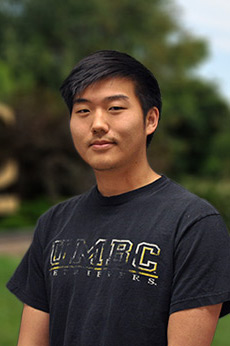
Paul Oh, Visual Arts
Enigma Squad: Short Film Narrative
Faculty Mentor: Cathy Cook
Expected Graduation Dates: Spring 2017
Cinema is a reflection of the real world. While some elements may be exaggerated, the core of a movie should mirror that of the human experience. As audience members, we experience the routine of a fictional character and if done correctly, sympathize with the protagonist’s journey. The goal of this project is to produce a short film called Enigma Squad. The story is about a young college photographer who delves into the disappearance of two missing students. The primary cast will be UMBC students of diverse ethnic backgrounds. The purpose of this film is to critique the college status quo. This includes highlighting racism and sexism found on college campuses. The goal of this film is to promote diversity within movies and explore controversial topics neglected by popular media.

Himadri Patel, Psychology
Brain Mechanisms of Stress-Induced Analgesia
Faculty Mentor: Raimi L. Quiton
Expected Graduation Date: Spring 2017
For several decades, researchers have been studying the phenomenon in which exposure to intense stress suppresses the perception of pain, known as stress-induced analgesia (SIA). From an evolutionary perspective, SIA is part of the adaptive fight-or-flight response mediated by the sympathetic nervous system that enhances an individual’s ability to survive a crisis situation; pain suppression is a critical component of this response as it enables individuals to escape a threat even if they have sustained an injury. Studies have also found involvement of the endogenous opioid system in SIA. This study focuses on identifying specific brain areas and the neural mechanisms involved in SIA. In this study, painful heat stimuli will be applied to the subjects while they perform a computerized task in the MRI scanner and functional brain imaging data is collected. Subjects will participate in two sessions on separate days: (1) the control session in which painful heat stimuli are applied while subjects perform a non-stressful task and (2) the stress session in which painful heat stimuli are applied while subjects perform a stressful math task. Comparison of pain ratings and functional neuroimaging data between the two sessions will allow us to measure the magnitude of and brain networks involved in SIA, respectively.

Sunitha Pawar, Biological Sciences
Investigating the Genetic Interactions among CPR5, SIM, and SMR1
Faculty Mentor: Hua Lu
Expected Graduation Date: Spring 2017
Plant development and defense mechanisms rely heavily on accurate cell-cycle control. Our recent published work showed that SIAMESE (SIM) and SIM-RELATED 1 (SMR1), two homologous cyclin-dependent kinase inhibitor genes, play differential roles in regulating cell cycle progression and defense in Arabidopsis. The CPR5 gene encodes a nuclear membrane protein that interacts with SMR1 and SIM. Mutations in SIM and SMR1 confer lower cell ploidy and reduced disease resistance while mutations in CPR5 confer lower ploidy and constitutive defense. Thus while SIM, SMR1 and CPR5 are positive regulators of cell ploidy, SIM and SMR1 positively regulate plant defense and CPR5 has a negative role in plant defense. However how CRP5, SIM, and SMR1 interact to affect cell ploidy and immune response of Arabidopsis has not been well understood. One recent study reported that the sim smr1 mutant suppressed cpr5 morphological phenotypes and resistance. However, preliminary data from Dr. Lu’s lab do not support this statement. The main purpose of this project is to investigate the genetic interaction between CRP5, SIM, and SMR1, using sim, smr1, and cpr5 mutants. To reach this goal, I will compare the phenotypes of single mutants (cpr5, sim, and smr1), double mutants (cpr5sim and cpr5smr1), and triple mutants (cpr5simsmr1) with various assays for defense and cell cycle related phenotypes.
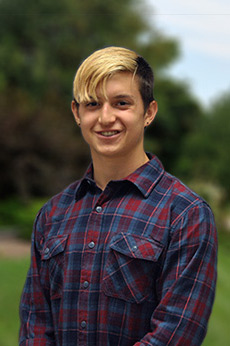
Ben Price, Philosophy
The Nature of Friends: An Analysis of Moral Relationships
Faculty Mentor: Thorian Harris
Expected Graduation Date: Spring 2017
Humans are fundamentally social creatures, and it is difficult to overstate the importance of personal relationships to our lives. At times however, it can be difficult to determine what is involved, for example, in being a good friend or family-member. These sorts of problems are extremely important to most people, having struggled with falling-outs and breakups. I plan to explore the notions of human nature, friendship, and the connection between them as articulated by Classical Chinese philosophers Xunzi and Mengzi. These Confucian thinkers disagree about the origins of morality and its cultivation in our social interactions. My research will contrast the Ancient Chinese authors with the work of American Pragmatist John Dewey. The pragmatic lens will help make the classical texts relevant, and bring out what practical wisdom there might be for making our relationships healthier and more fulfilling.
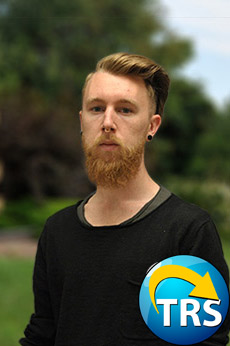
Sean Radaskiewicz, Visual Arts
Station North, Baltimore: Homelessness and the Individual
Faculty Mentor: Calla Thompson
Expected Graduation Date: Fall 2018
This is a critical time in the discussion of equality and justice in Baltimore. The riots and demonstrations last April, ignited by the death of Freddie Gray, highlighted issues related to racial and socio-economic class divisions. Homeless individuals are visible casualties of these divides, yet as individuals they are often invisible to much of society. In an effort to make some of these individuals visible, I will interview and make individual photographic portraits of ten homeless persons with whom I have become acquainted in the past year. The photographs will be exhibited in a gallery. I will also make 50 posters of the portraits. These will be exhibited on streets throughout Baltimore. The posters will include the individual’s first name, information from our interview, and a QR code. The QR code will link to a site with donation information for a local food bank that helps homeless individuals, as well as further information from the interviews. This work will personify the individual. Homeless people who participate will be able to take credit for helping others who share their struggle and receive a meal as thanks for taking part.
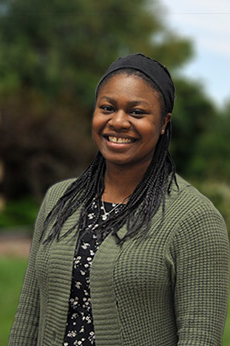
Rebekah Rashford, Biological Sciences
Ribosomal Protein Binding during Ribosomal RNA Maturation
Faculty Mentor: Lasse Lindahl
Expected Graduation Date: 2018
Genetic and biochemical studies of the ribosome show that ribosome formation is a complex process of synthesis and assembly of individual components, namely ribosomal proteins (rp) and ribosomal RNA (rRNA). However, the exact timing of individual rp addition to ribosome assembly RNA intermediates is not fully understood. This project was designed to develop a method for determining these binding patterns without interrupting ribosome biogenesis. Synthesis of individual tagged rp’s were induced and co-immunoprecipitated, along with the specific rRNA segment to which the rp binds. RNA was extracted from the immune precipitate and loaded on slot blots. The blots were then probed with segment-specific oligo-probes loosely corresponding to rRNA cleavage sites (a process we termed “slot-northern”). When a signal showed the slot-northern indicating a probe had bound to the rp/RNA complex, it was viewed against the known specific probe-segments of the binding probe and used to deduce the location of binding for that individual rp onto the maturing rRNA. By gaining this information about ribosomal proteins, we may better understand the ribosome in its entirety and add to the foundational understanding of one of the most important complexes in life.
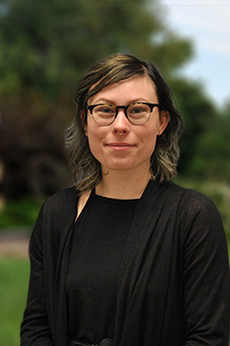
Victoria Schanken, Graphic Design and Print Media
Organization of a Cohesive Art Exhibition
Faculty Mentor: Sandra Abbott
Expected Graduation Date: Spring 2018
As an intern at the Center for Art, Design and Visual Culture (CADVC) I will learn art handling, preservation, research and documentation of art, all of which are essential skills in a gallery setting. With my URA grant, I will attend a professional conference and showcase the aforementioned skills through documentation of a special gallery project. The project will culminate in a professionally presented, contemporary art exhibition. The exhibition I will organize and curate includes a collection of approximately 150 artworks given to the CADVC, some of which are in very poor condition. The works are primarily mixed media collages created by the artist George Steele. After researching, preparing and reframing the work I will organize, interpret and present a portion to the public based on sound curatorial principles. I will gain knowledge of best practices in curatorial work through attendance of the American Alliance of Museums’ Annual Meeting as well as through skills I will learn during my internship at CADVC and through other coursework.
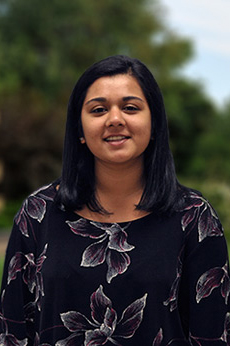
Aarti Shah, Chemistry and Biochemistry
Synthesis of Flexible GS-441524 for Potential Anti-Viral Effects
Faculty Mentor: Katherine Seley-Radtke
Expected Graduation Date: Spring 2018
As we make our way into 2016, fatal worldwide viruses such as Ebola, Hepatitis C, HIV, and MERS coronavirus (CoV) remain without a vaccine. As they have been the subject of extensive media coverage in recent years, viruses such as Ebola can have mortality rates up to an alarming ninety percent, rendering the need for a successful treatment as absolutely essential. However, a recent compound synthesized by Gilead Pharmaceuticals has shown significant activity against a wide variety of viral infections ranging from Ebola to MERS-CoV. This lead compound has piqued interest in the Seley-Radtke lab and led to the development of this project. The main goal is to create flexible-base or ‘fleximer’ analogues to act as an inhibitor of viral polymerases. The fleximer concept was designed by Dr. Seley-Radtke and involves modification of a bicyclic nucleoside base through separation into distinct imidazole (or pyrrole) and pyrimidine moieties connected by a single C-C bond. This fleximer concept has been proven to increase binding affinity to target enzymes as well to add the ability for the compound to overcome the point mutations that are a common mechanism of viral drug resistance. My project will be to synthesize four fleximers which will be tested biologically by Seley-Radtke Lab collaborators for their antiviral potential.
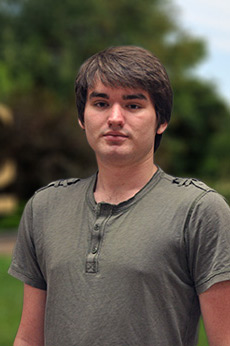
Alexander Sievers, History
The Question of “Left-Wing Fascism” within the British Union of Fascists in the 1930s
Faculty Mentor: Dan Ritschel
Expected Graduation Date: Fall 2016
Fascist movements in interwar Europe, like the infamous Nazi Party and Mussolini’s Fascists, are generally positioned on the far right of contemporary political culture. Yet the small but significant fascist movement in England was led by Sir Oswald Mosley, a former minister in the Labour government in 1929-30, and attracted a significant number of other defectors from the Labour party. Some historians have come to describe these men as “left-wing fascists,” a term that is meant to indicate the paradoxical nature of Mosley’s movement, since fascism is generally held to be an ideology from the right edge of the political spectrum. My research will seek to place this notion of “left-wing fascism” under a critical lens by compiling a database of fascist recruits from the Labour party and the wider Left in order to determine where they truly fell on the political spectrum. By examining their published works and statements before, during, and after their association with Mosley’s movement, I believe that I will be able to show that those who whole-heartedly embraced fascism were never truly “left-wing” at all, and those who were genuinely trying to look out for the proletariat were only temporarily misled into supporting fascism and quickly jumped ship once the more conservative aspirations of the fascist party were revealed.
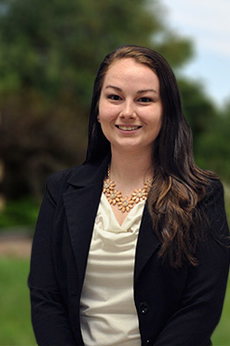
Amelia Smith, Biological Sciences
Investigating the Function of the shep Gene in Cell Migration
Faculty Mentor: Michelle Starz-Gaiano
Expected Graduation Date: Spring 2017
Cell migration is an important process as it is necessary for proper immune function, embryonic development, and injury repair in all animals. It is also the mechanism behind cancer metastasis. To improve treatment for conditions caused by faulty cell migration, we must understand how the process is molecularly controlled. Border cell migration in Drosophila melanogaster, the common fruit fly, is a good model for these investigations as there is high conservation of genes between D. melanogaster and humans. During normal border cell migration, a group of cells travels from one side of a developing egg chamber to the other. Previous investigations into a D. melanogaster gene called shep indicate it may be required for this important process. Using immunohistochemistry, RNA interference, and a transposase experiment along with other modern genetic techniques, I will determine where Shep protein is present in an egg chamber and how disruption of the gene affects cell migration. A mutant fly line that has a GAL4 driver inserted into the shep gene will be used to drive expression of Green Fluorescent Protein (GFP) where Shep protein is normally expressed. I will also use mutant strains that result in the knockdown of shep and observe the effects on border cell migration. Newer genetic techniques will be used to generate loss of function shep alleles thus allowing me to observe cell migration in the absence of shep. I hypothesize that cell migration will be delayed in these mutants. This result would reveal that Shep regulates cell migration in D. melanogaster and lead researchers to investigate the functions of similar proteins in humans.

Sigfredo Soto, Physics
Numerical Modelling of the Gamma-Ray Emission Detected from Extragalactic Relativistic Jets
Faculty Mentor: Markos Georganopoulos
Expected Graduation Date: Spring 2017
There is currently a mismatch between our observational and theoretical capabilities in our effort to understand the gamma-ray variable emission of blazars coming from the vicinity of a black hole. NASA’s Fermi gamma-ray satellite shows extreme variability in blazars and currently we lack the tools for modelling these variations accurately and understand the physical conditions experienced in these extreme environments. What is usually done with the one zone numerical models available is to model a snapshot of the event and not the entire time evolution of the flares. This does not allow us to gain insight on the physics of the variability. Our goal is to develop realistic numerical simulations to model the variable gamma-ray emission of luminous blazars, powerful relativistic jets emanating from the vicinity of the supermassive black holes found in the centers of active galaxies. The codes developed will become publicly available so that the wider astrophysics community will have access to them.

Savannah Steinly, Chemical, Biochemical and Environmental Engineering
Understanding the Photochemical Fate of Organometallic Compounds
Faculty Mentor: Lee Blaney
Expected Graduation Date: Winter 2018
Organometallic chemicals are used for a variety of applications, including agriculture, medicine, and electronics. This project focused on four organometallic classes (i.e., organo-arsenic, platinum, -selenium, and -tin). These compounds are introduced to the environment through wastewater treatment plants (Pt, Sn), the shipping industry (Se), and agricultural runoff (As). The unique properties of these compounds, and the corresponding inorganic metals, present distinct environmental and human health concerns; however, few studies on the photolytic transformation of these organometallics in the environment have been undertaken. In this study, we investigate and quantify the phototransformation kinetics of each of the six species of interest using several methods. First, we measure the molar extinction coefficients for organometallic chemicals across a solar irradiation spectrum. We then identify the time-based photodegradation kinetics of organometallics in environmental systems. Finally, we perform actinometry to measure the net photon flux of the solar simulator and evaluate fluence-based rate constants and quantum yields. The results of this study will provide identification of quantum yields for the six compounds across a pH gradient and irradiation spectrum. That information will be used in ongoing work to identify the photodegradation kinetics of organometallics in environmental systems.
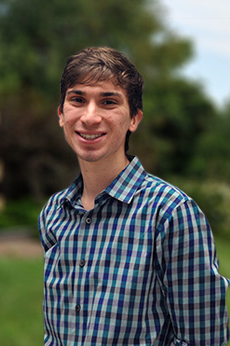
Julian Tash, Asian Studies and History
Objects of Devotion: Exhibiting Sculptural Images of the Buddha
Faculty Mentor: Preminda Jacob
Expected Graduation Date: Spring 2018
Buddhist statues are created for a wide variety of purposes, but seldom are they intended for a museum or gallery setting. In displaying this statuary, each museum must make difficult choices when deciding on how to meaningfully impart contextual nuances about the objects to visitors at an exhibition. In their original context, statutes of the Buddha generally reside in dark temples, surrounded by food and incense. In some religious practices these statues are clothed so that the contours of the sculpture remain unseen. Because these objects are both religious and artistic in nature, appreciated by devotees, art enthusiasts, and those interested in Buddhism, museums have developed a variety of approaches to displaying images of the Buddha. While emulating real temples risks creating an ersatz environment, presenting Buddhist statues in completely sterile spaces is equally disingenuous. The exposure of residents of Western countries to depictions of the Buddha largely takes place in museums. It is crucial that we understand how the different modes of museum display impart meaning since the presentation these statues plays a critical role in shaping contemporary Western understandings of Buddhism.
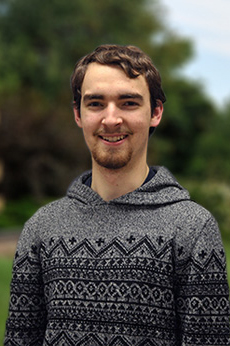
Zach Thomas, Music
Composer-Performer Communication Methods in Contemporary Classical Music: A Case Study
Faculty Mentor: Linda Dusman
Expected Graduation Date: Fall 2016
This research provides new methodological insights for modern classical composers in the verbal description and written notation of new music. As style in new classical music is extremely diverse, it is often not clear how performers should interpret finer aspects of the musical notation for a new work, and composers are often expected to coach the performers in its premiere. Finding the best written and verbal communication methods for new music is both challenging and extremely important for composers. To gain new insights into this issue, the author will record all interactions with the performers in rehearsals of two of his works. Using the recordings, the written musical scores, and recordings of the performances, the author will evaluate which methods of written notation and verbal description were most successful in communicating the exact musical intent to the performers. Annotated musical scores (one for each composition performed) will provide documentation of each notated musical idea in terms of its performance success, how it was received and described in rehearsal, and any alternate notations which the performers suggested.
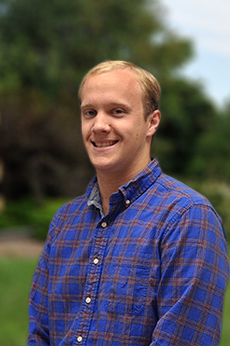
Nick Vaccaro, Biochemistry and Molecular Biology
Detection of Specific Single Soft Particles Binding to E-AB Sensors in Real Time
Faculty Mentor: Ryan White
Expected Graduation Date: Spring 2017
Electrochemical aptamer-based (E-AB) sensors can be utilized to detect a multitude of different target molecules in a sample. Current methods, however, are limited to ensemble measurements of a large number of target molecules. Conversely, specific single molecule sensing at low detection limits represents a highly sensitive method of detection of analytes in a sample. In this project, I aim to detect Immunoglobulin E (IgE), a protein that is involved with the immune response in the human body, with specific single molecule sensitivity. Nonspecific detection of single IgEs by previous experimental methods involved observing discrete current reductions in real-time at a gold nanodisk electrode due to IgE blocking part of its electroactive surface area. The proposed method, however, involves modifying the electrode surface with a DNA aptamer specific to IgE, in which only IgE collisions and binding will result in similar current reductions due to the blocking of the electroactive surface. Under these conditions, the protein should bind to the aptamer instead of colliding with the electrode surface. Detecting this particular protein with the proposed protocol will show that DNA aptamers can be utilized for specific electrochemical single particle detection.
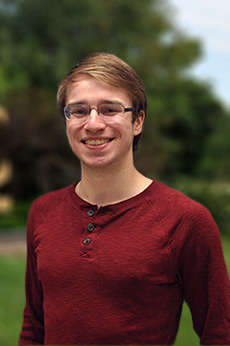
Kevin Whitley, Physics
Investigating a New TeV Source Class, and the Implications for Re-Ionizing the Universe
Faculty Mentor: Eileen Meyer
Expected Graduation Date: Spring 2017
About 400 thousand years after the Big Bang, the Universe cooled such that Hydrogen nuclei and electrons were able to recombine and form neutral Hydrogen. 150 million to 1 billion years later, matter in the Universe, consisting primarily of Hydrogen, was once again split up into positive nuclei and negative electrons. The cause of this “re-ionization” remains as one of the biggest open questions in modern astrophysics. Potential candidates for sources of ionizing radiation include the first stars, hot accretion disks around super -massive black holes, and dwarf galaxies. When the Chandra X-ray telescope launched, it discovered that the giant plasma jets sometimes produced by the super-massive black holes in the centers of galaxies were unusually bright in the X-rays. Assuming that these X-ray photons are synchrotron radiation from a highly energetic electron population, we predict that Cosmic Microwave Background photons Compton-scattered by the jet will produce TeV gamma rays, the highest energy light currently observable. Recent theoretical work shows that these gamma rays will deposit their energy locally, implying that these jets may have played a role in re-ionization. Using publicly available multi-wavelength observations of around three dozen anomalously X-ray bright jets, we will predict the TeV gamma ray production of each jet subject to remaining unknowns, such as the speed of the jet several thousand light years from the black hole. This will allow us to construct a catalog of potential TeV-producing active galaxies to observe with TeV telescopes currently being constructed. Additionally, we will be able to use this analysis to make inferences about the larger active galaxy population and the total TeV production of jets per cosmic volume, aiding us in understanding the importance of jets in re-ionization.
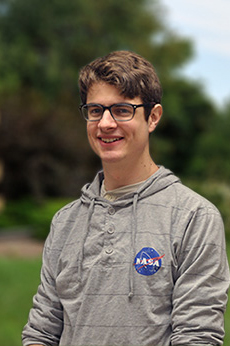
Michael Wolfe, Physics
Quantum Error Characterization for Singlet-Triplet Qubits by Randomized Benchmarking
Faculty Mentor: Jason Kestner
Expected Graduation Date: Spring 2017
A quantum computer has the ability to solve a certain class of problems exponentially faster than a classical computer by harnessing the laws of quantum mechanics. Of the leading candidates for qubits, confined electrons in the singlet and triplet spin states have demonstrated entanglement, a requirement for a two-qubit logical CNOT operation. Despite their fast operation times, singlet-triplet qubit operations accumulate error induced by a noisy spin and charge environment. We investigate two-qubit operations that have been corrected for static noise sources. We perturb the singlet-triplet Hamiltonian with time-dependent noise sources to simulate realistic experimental conditions for the qubits. These perturbed Hamiltonians generate a new set of corrupted two-qubit gates which we use to simulate a realistic quantum computation via randomized bench marking. By investigating the errors accumulated over a long sequence of operations we can characterize the average error per operation.
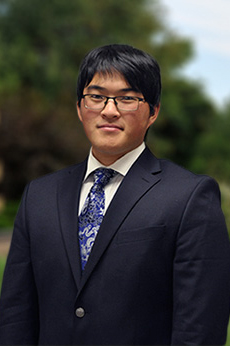
Henry Wu, Biological Sciences and Interdisciplinary Studies
Cardiovascular Health Education Using Board Games
Faculty Mentor: Krystl Haerian
Expected Graduation Date: Spring 2017
Cardiovascular disease is the leading cause of death in the developed world, and more specifically the number one cause of death in Baltimore City. One of the most effective ways to combat cardiovascular disease is through effective education. The purpose of this study is to pilot two pedagogically different board games intended to teach cardiovascular health concepts. A rote learning and an inquiry based board game were developed to test the effectiveness of the board game, with the primary difference residing in the different question sets. Games are a powerful learning tool because they provide the user immediate feedback and allow the user to learn from their mistakes. To analyze the results of our study, we are going to utilize survey models validated among pertinent disciplines; we will use one model to measure engagement and one to measure retention. By conducting this study we hope to contribute to cardiovascular health education by facilitating real-world application and increasing engagement in Baltimore City.

Yun Yi Zheng, Media and Communication Studies and Asian Studies
Broadcasting Eating: An Ethnographic Analysis of Muk-bang Consumers
Faculty Mentor: Donald Snyder and Bryce Peake
Expected Graduation Date: Spring 2017
A growing phenomenon originating in South Korea in 2013 features young attractive people sitting in front of a webcam, broadcasting themselves eating large quantities of food, while textual chatting with their invisible viewers. The term for this is Muk-bang, which combines the Korean words meokneun (eating), and bangsong (broadcast). Muk-bang has been growing in popularity throughout Asia, with the most popular videos on YouTube reaching two million viewers. Popular muk-bang creators report making more than a hundred thousand dollars a year. Press coverage and popular videos present Muk-bang as a ‘weird’ practice by presenting the idea of fetishization, vicarious consumption, and virtual relations guarding against loneliness and ‘eating alone’. While the press and popular videos provides valuable insights and assumptions, we can learn more by interviewing Muk-bang audiences. An ethnographic research with Muk-bang audiences allows us to examine cross-cultural representations of food on new media. Of specific interest to this study, China has become one of the main participators in this cultural practice. While the gender imbalance in South Korea has been declining over the last two decades, China has only recently eliminated the one child policy, leaving many more men in the country than women. How does Muk-bang as a cultural practice reflect this specific condition – what pleasures and connections are the participants gaining? For this project, I will conduct ethnographic interviews and participant observation in order to examine the benefits participants are gaining from participating in Muk-bang phenomenon. The final product of this project will be a Tumblr page (English and Chinese) with visual and audio contents that reflects on the research conducted from interviewing Muk-bang followers.